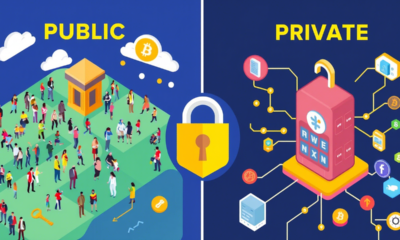DeFi & Yield Farming
What Is DeFi and Why Does It Matter?

|
Getting your Trinity Audio player ready...
|

What Is DeFi and Why Does It Matter?
Decentralized Finance, or DeFi, is a rapidly growing sector in the blockchain and cryptocurrency space that aims to provide traditional financial services in a decentralized manner. Unlike traditional finance, which relies on centralized institutions like banks and brokers, DeFi operates on blockchain technology, allowing users to interact directly with smart contracts and eliminate intermediaries. This article delves into the key aspects of DeFi, its importance, and how you can navigate this innovative landscape.
Introduction to DeFi
DeFi, short for Decentralized Finance, is a collective term for financial applications built on blockchain technology. These applications, often referred to as DApps, offer a wide range of services, including lending, borrowing, trading, and insurance, without the need for traditional financial institutions. The core idea behind DeFi is to create an open, transparent, and accessible financial system that is not controlled by any single entity.
Key Features of DeFi:
- Decentralization: DeFi platforms are built on decentralized networks like Ethereum, ensuring no single point of failure.
- Smart Contracts: Automated, self-executing contracts that facilitate, verify, and enforce the negotiation or performance of a contract.
- Transparency: All transactions are recorded on the blockchain, making them visible and verifiable by anyone.
- Accessibility: DeFi services are available to anyone with an internet connection, regardless of their location or bank account status.
The Importance of DeFi
DeFi is gaining traction for several compelling reasons. Here are some key points that highlight its significance:
- Financial Inclusion:
- Global Reach: DeFi can provide financial services to the unbanked and underbanked populations, particularly in developing countries.
- Lower Barriers: Traditional financial systems often have high entry barriers, such as minimum balances and credit checks. DeFi lowers these barriers, making finance more accessible.
- Transparency and Security:
- Blockchain Technology: The immutable nature of blockchain ensures that all transactions are secure and cannot be altered.
- Public Ledger: Transactions are recorded on a public ledger, allowing users to verify and audit them in real-time.
- Liquidity and Efficiency:
- 24/7 Market Access: DeFi platforms operate non-stop, providing 24/7 access to financial markets.
- High Liquidity: Automated market makers (AMMs) ensure high liquidity, reducing slippage and making trading more efficient.
- Innovation and Flexibility:
- New Financial Instruments: DeFi has introduced innovative financial instruments such as stablecoins, yield farming, and liquidity pools.
- Interoperability: DeFi protocols can interact with each other, creating a more flexible and interconnected financial ecosystem.
How DeFi Works
To understand how DeFi operates, let’s break down the key components:
- Blockchain Technology:
- Ethereum: The most popular blockchain for DeFi, providing a secure and transparent platform for DApps.
- Smart Contracts: These are the backbone of DeFi, allowing for automated and trustless transactions.
- Decentralized Exchanges (DEXs):
- ** Automated Market Makers (AMMs):** Protocols like Uniswap and Curve use AMMs to facilitate trading without order books.
- Peer-to-Peer (P2P) Trading: Platforms like IDEX and Radar Relay allow users to trade directly with each other.
- Lending and Borrowing:
- Aave and Compound: These platforms enable users to lend and borrow cryptocurrencies, earning interest or accessing funds.
- Collateralized Loans: Users can take out loans by locking up collateral, often in the form of cryptocurrencies.
- Stablecoins:
- USD Coin (USDC) and Dai (DAI): These are cryptocurrencies pegged to the value of the US dollar, providing stability in a volatile market.
- Synthetic Assets: Protocols like Synthetix allow users to create synthetic versions of traditional assets, enabling exposure to a wide range of investment opportunities.
- Insurance:
- Nexus Mutual andCover Protocol: These platforms offer decentralized insurance, protecting users against smart contract failures and other risks.
Benefits of DeFi
The benefits of DeFi are numerous and impactful:
- Accessibility:
- No Central Authority: DeFi eliminates the need for intermediaries, making financial services more accessible to a global audience.
- Low Fees: Transactions on DeFi platforms often have lower fees compared to traditional financial institutions.
- Transparency:
- Open Source Code: The code for DeFi platforms is open source, allowing for independent audits and verification.
- Public Transactions: All transactions are recorded on the blockchain, ensuring transparency and accountability.
- Yield Opportunities:
- Staking and Yield Farming: Users can earn rewards by staking their cryptocurrencies or participating in yield farming.
- Liquidity Pools: Providing liquidity to DEXs can earn users a share of trading fees.
- Decentralized Governance:
- DAOs (Decentralized Autonomous Organizations): DeFi projects often use DAOs for governance, allowing community members to vote on protocol changes and improvements.
Risks of DeFi
While DeFi offers many benefits, it is not without its risks. Here are some key considerations:
- Smart Contract Risks:
- Bugs and Vulnerabilities: Smart contracts are only as secure as their code. Bugs and vulnerabilities can lead to significant losses.
- Auditing: It is crucial to use DeFi platforms that have been audited by reputable firms.
- Market Volatility:
- Price Fluctuations: Cryptocurrencies are highly volatile, and this can impact the value of your holdings and the stability of DeFi protocols.
- Liquidity Risk: Low liquidity in certain markets can result in high slippage and difficulty in executing trades.
- Regulatory Uncertainty:
- Legal Gray Areas: The regulatory landscape for DeFi is still evolving, and there is uncertainty about the legal status of many DeFi platforms.
- Compliance: Users should be aware of the legal and tax implications of using DeFi services in their jurisdiction.
- User Experience:
- Complexity: DeFi can be complex for new users, requiring a good understanding of blockchain technology and smart contracts.
- Security Practices: Users must take responsibility for their own security, including managing private keys and using secure wallets.
Practical Tips for Getting Started with DeFi
If you’re interested in exploring DeFi, here are some practical tips to help you get started:
- Educate Yourself:
- Understand the Basics: Learn about blockchain technology, smart contracts, and the different types of DeFi platforms.
- Stay Informed: Follow reputable sources for the latest news and developments in the DeFi space.
- Choose the Right Wallet:
- Non-Custodial Wallets: Use a non-custodial wallet like MetaMask or Trust Wallet to manage your cryptocurrencies.
- Security Features: Ensure your wallet has strong security features, such as hardware wallets for cold storage.
- Start with Trusted Platforms:
- Reputation: Begin with well-established and audited platforms like Uniswap, Aave, and Compound.
- Community Feedback: Read reviews and seek feedback from the community to gauge the reliability of a DeFi platform.
- Manage Your Risks:
- Diversification: Diversify your investments across multiple DeFi platforms to spread risk.
- Insurance: Consider using decentralized insurance platforms to protect your investments.
- Stay Updated with Gas Fees:
- Network Costs: Ethereum gas fees can be high during peak times, so monitor them and plan your transactions accordingly.
- Layer 2 Solutions: Explore Layer 2 solutions like Optimism and Arbitrum to reduce transaction costs.
- Participate in Governance:
- DAOs: Join DAOs to have a say in the development and direction of DeFi projects.
- Token Staking: Stake your governance tokens to earn rewards and influence protocol decisions.
Current Trends and Future Outlook
The DeFi space is constantly evolving, and staying updated with the latest trends is crucial:
- Cross-Chain DeFi:
- Interoperability: Projects are working on cross-chain solutions to enable interoperability between different blockchains, expanding the DeFi ecosystem.
- Regulatory Developments:
- Government Involvement: Governments and regulatory bodies are increasingly taking notice of DeFi, and the future will likely see more defined regulatory frameworks.
- Institutional Adoption:
- Corporate Interest: More institutions are exploring DeFi, which could lead to increased stability and legitimacy in the sector.
- User Experience Improvements:
- Simplified Interfaces: DeFi platforms are focusing on improving user experience, making it easier for new users to navigate the space.
- Environmental Impact:
- Sustainable Solutions: The environmental impact of DeFi is a growing concern, and there is a push for more sustainable blockchain solutions.
Conclusion
DeFi is a game-changing innovation in the financial industry, offering a decentralized, transparent, and accessible alternative to traditional finance. While it comes with its own set of risks, the benefits and potential for growth are significant. By educating yourself, choosing trusted platforms, and managing your risks, you can navigate this exciting space and potentially reap substantial rewards.
Whether you are a seasoned investor or a curious newcomer, DeFi is a topic worth exploring. As the ecosystem continues to evolve, it is poised to play a crucial role in shaping the future of finance. Start your DeFi journey today and be a part of this revolutionary movement.
Key Takeaway: DeFi is revolutionizing the financial industry by providing decentralized, transparent, and accessible services. While it comes with risks, the benefits and potential for growth make it a compelling area to explore.

DeFi & Yield Farming
Advanced Tokenomics: Creating Sustainable Incentive Models


Advanced Tokenomics: Creating Sustainable Incentive Models
Introduction
In the rapidly evolving world of cryptocurrencies and decentralized finance (DeFi), the term “Advanced Tokenomics” has gained considerable attention. Understanding advanced tokenomics is essential for the development of sustainable incentive models, which are key to ensuring the longevity and effectiveness of blockchain projects. In this article, we will delve into the principles of advanced tokenomics, explore its importance, and provide practical insights into crafting sustainable incentive models that can thrive in a competitive market.
What is Tokenomics?
Tokenomics combines “token” and “economics” to describe the economic model that underpins a cryptocurrency or digital token. It encompasses the creation, distribution, and circulation of tokens within a cryptocurrency ecosystem and aims to create a balanced economic environment that promotes growth, sustainability, and user engagement.
Key Components of Tokenomics
- Token Supply: Determines how many tokens will be created, which can be fixed or variable.
- Token Distribution: Details how tokens are allocated among stakeholders, including founders, investors, and the community.
- Token Utility: Explains the purpose that a token serves within its ecosystem, whether as a means of payment, governance, or stake-weighted voting.
- Incentives: Strategies that reward early adopters, contributors, and stakeholders to promote interaction and investment within the ecosystem.
The Importance of Advanced Tokenomics
Advanced tokenomics goes beyond basic principles to create more sophisticated models that consider market dynamics, user behavior, and long-term viability. By integrating advanced tokenomics into project designs, developers can address several critical areas:
Ensuring Long-Term Sustainability
- Market Stability: Advanced models can mitigate price volatility, which is often experienced in the cryptocurrency market. Techniques like dynamic supply adjustments can assist in maintaining stability.
- User Retention: Sustainable incentive models encourage users to remain engaged over time through staking rewards or loyalty programs.
Aligning Incentives
Creating models where the interests of different stakeholders are aligned is crucial. When all parties—users, developers, and investors—benefit from the growth of an ecosystem, it promotes collaboration and reduces conflict.
Fostering Community Ownership
Incorporating community-driven principles fosters a sense of ownership among token holders. Mechanisms such as decentralized governance can empower users to have a say in the protocol’s future, enhancing commitment and loyalty.
Crafting Sustainable Incentive Models
Creating an effective incentive model requires careful consideration and planning. Here are several strategies to keep in mind:
Define Clear Token Utility
Establishing a clear purpose for your token can enhance its value. Tokens could be utilized for transactions, used in governance, or serve as collateral in DeFi protocols. The clearer the utility, the easier it is to attract users and investors.
Implement Staking Mechanisms
Staking allows users to lock up their tokens in exchange for rewards, thus ensuring that they have skin in the game. This not only incentivizes holding but also contributes to network security. Consider deploying a tiered staking system to reward larger stakeholders while still accommodating smaller holders.
Utilize Buyback and Burn Strategies
This strategy involves the project using a percentage of its revenue to buy back tokens from the market and subsequently burn them, reducing the total supply. This approach can increase rarity and encourage upward price movements, all while demonstrating the project’s commitment to sustainability.
Create Incentives for Contributions
Encouraging user participation and contributions, whether through development, marketing, or community support, fosters a vibrant ecosystem. Consider implementing bounties, bonuses, or referral rewards to stimulate activity within your platform.
Monitor and Adapt
The cryptocurrency landscape is highly dynamic. Regular assessment of your tokenomics model is crucial. Use analytics to track user behavior and market trends, and be prepared to adapt your strategies as necessary. Flexibility can be your strongest asset in maintaining sustainability.
Examples of Successful Advanced Tokenomics
Ethereum
Ethereum implements a robust economic model that includes the Ether token as a means of transaction and gas fees, a well-defined supply schedule, and robust staking incentives through Ethereum 2.0. This blend of utility and user incentivization has propelled its growth and adoption.
Binance Smart Chain (BSC)
Binance Smart Chain employs a dual-token system comprising BNB for transaction fees and governance, alongside many tokens in its DeFi ecosystem. Its incentive models provide liquidity mining and yield farming opportunities, driving user engagement and transaction volume.
Conclusion
Advanced tokenomics plays an essential role in building sustainable incentive models within the blockchain ecosystem. By utilizing clear token utility, implementing effective staking mechanisms, and continuously monitoring user engagement, projects can create models that contribute to long-term growth and community trust.
Leveraging advanced tokenomics enhances not only the project’s financial health but also fosters an engaged community that feels valued and invested in the ecosystem’s future. As the blockchain space continues to evolve, embracing these principles will be critical for developers looking to make their mark.
Call to Action
If you’re a project developer or a crypto enthusiast looking to explore the potential of advanced tokenomics further, start by reviewing your current incentive models. Apply these insights to create robust structures that support sustainability and community engagement.
DeFi & Yield Farming
Introduction to Liquidity Pools and How They Work


Introduction to Liquidity Pools and How They Work
In the rapidly evolving world of cryptocurrency and decentralized finance (DeFi), liquidity pools have emerged as a fundamental concept. Understanding liquidity pools and how they work can not only enhance your knowledge of the DeFi space but also present new opportunities for investment and trading.
What are Liquidity Pools?
Liquidity pools are collections of digital assets or tokens held in a smart contract within a decentralized exchange (DEX). These pools provide liquidity, enabling traders to buy and sell tokens without needing a single buyer or seller to facilitate the transaction. Instead, the liquidity is pooled together, allowing for seamless transactions and price stability.
The Importance of Liquidity Pools
Liquidity is crucial for any trading platform, especially in the cryptocurrency market, where asset prices can fluctuate wildly. Without liquidity, users would struggle to buy or sell assets quickly or at fair prices. Liquidity pools alleviate this problem in several ways:
- Facilitating Trades: Enables users to trade 24/7 without the need for an order book.
- Reduced Slippage: With sufficient liquidity, the price impact of large trades is minimized.
- Earning Potential: Users can earn passive income by providing liquidity to these pools.
How Do Liquidity Pools Work?
1. The Mechanism of Liquidity Pools
Liquidity pools operate through smart contracts. When users deposit tokens into a liquidity pool, they receive liquidity provider (LP) tokens in return. These LP tokens represent the user’s share in the pool and can be traded, sold, or redeemed for the underlying assets.
Here’s how the process works:
- Depositing Assets: Users provide tokens by depositing them into the liquidity pool, typically in pairs (e.g., ETH/USDT).
- Automated Market Maker (AMM): Transactions occur through an AMM model, which determines the prices based on the ratio of the assets in the pool. The pricing formula often used is ( x \times y = k ), where ( x ) and ( y ) are the respective quantities of two tokens in the pool, and ( k ) is a constant.
- Earning Fees: Liquidity providers earn a portion of the trading fees generated from transactions that occur in the pool, proportional to their share.
2. Types of Liquidity Pools
While all liquidity pools share the same primary objective—providing liquidity—different types of liquidity pools cater to varied trading strategies:
- Stablecoin Pools: These pools contain stablecoins like USDC or DAI, making them less volatile.
- Single Asset Pools: Users can provide a single type of token, simplifying the process.
- Reward Pools: Some pools provide users with additional rewards in the form of governance tokens or other incentives.
3. The Risks Associated with Liquidity Pools
While liquidity pools can be lucrative, they also come with their share of risks. Understanding these risks is crucial for making informed decisions:
- Impermanent Loss: This occurs when the value of assets in the pool changes compared to holding them separately. The more volatile the assets, the higher the potential impermanent loss.
- Smart Contract Risks: Bugs or vulnerabilities in a smart contract can lead to loss of funds.
- Market Risks: Sudden market movements can affect the liquidity pool’s performance.
Benefits of Liquidity Pools
Engaging with liquidity pools can offer several advantages:
1. Passive Income
Liquidity providers earn fees from trades conducted in the pool. This passive income can be significant, especially in high-volume pools.
2. Access to DeFi Services
By participating in liquidity pools, users gain access to various DeFi services, including yield farming, lending, or borrowing.
3. Token Appreciation
In addition to trading fees, LP tokens themselves can appreciate in value, offering an additional return on investment.
Conclusion: Are Liquidity Pools Right for You?
Understanding liquidity pools and how they work is essential for anyone looking to engage in the DeFi ecosystem. Whether you are aiming to earn passive income, participate in decentralized finance, or hedge against market volatility, liquidity pools present numerous opportunities.
Call to Action
Before diving in, conduct thorough research and consider the risks involved. Start with smaller amounts and increase your investment as you grow more comfortable with the mechanics of liquidity pools.
By exploring liquidity pools and how they function, you’ve taken a step towards unlocking a new dimension of financial opportunities. Embrace the world of decentralized finance and keep learning to maximize your potential!
DeFi & Yield Farming
Step-by-Step Guide to Connecting Your Wallet to DeFi Platforms


Step-by-Step Guide to Connecting Your Wallet to DeFi Platforms
The decentralized finance (DeFi) revolution has transformed the way we think about finance. With the rise of DeFi platforms, users can lend, borrow, trade, and earn interest on their cryptocurrencies without traditional banks. However, to fully engage with this exciting landscape, you need to connect your digital wallet. This Step-by-Step Guide to Connecting Your Wallet to DeFi Platforms will provide you with everything you need to get started successfully.
What is a DeFi Platform?
Before we delve into the specifics of wallet connection, let’s briefly explore what DeFi platforms offer. DeFi platforms are decentralized applications (dApps) built on blockchain technology, primarily Ethereum. They facilitate various financial services, including:
- Lending and Borrowing: Users can lend their assets to others or borrow against collateral.
- Decentralized Exchanges (DEXs): These platforms allow users to trade cryptocurrency directly with one another.
- Yield Farming: This practice enables users to earn rewards by providing liquidity to the market.
The core principle of DeFi is the removal of intermediaries, offering users full control of their assets.
Why Connect Your Wallet?
Connecting your wallet to a DeFi platform allows you to interact directly with smart contracts. Your wallet acts as your gateway to participate in DeFi activities—be it trading NFTs, earning interest, or liquidity mining.
Types of Wallets
There are two main types of wallets commonly used in the DeFi space:
- Hot Wallets: These are connected to the internet and are more user-friendly, making them suitable for everyday transactions.
- Cold Wallets: These are hardware wallets that store your assets offline, providing increased security against hacks.
Step-by-Step Guide to Connecting Your Wallet to DeFi Platforms
Step 1: Choose Your Wallet
First, decide which wallet you want to use. Some popular options include:
- MetaMask: An easy-to-use browser extension and mobile app.
- Trust Wallet: A mobile wallet for both Android and iOS with a user-friendly interface.
- Ledger: A hardware wallet that offers advanced security features.
Step 2: Create and Fund Your Wallet
Once you’ve chosen your wallet, follow these steps:
- Download and Install: Download the wallet application or browser extension.
- Create a New Wallet: Follow the prompts to create a new wallet. Ensure you write down your recovery seed phrase and store it securely.
- Fund Your Wallet: Transfer some cryptocurrency (often ETH for Ethereum-based DeFi platforms) into your wallet. You can buy crypto through exchanges like Coinbase or Binance.
Step 3: Visit a DeFi Platform
Now that your wallet is set up and funded, you can visit a DeFi platform. Some popular platforms include:
- Uniswap: A leading decentralized exchange.
- Aave: A platform for lending and borrowing.
- Compound: Focused on lending with algorithmic interest rates.
Step 4: Connect Your Wallet
Here are the steps to connect your wallet to a DeFi platform:
- Initiate Connection: Look for the “Connect Wallet” button on the DeFi platform’s homepage.
- Select Your Wallet: Choose the wallet you are using (e.g., MetaMask, Trust Wallet).
- Authorize Connection: A pop-up will appear asking you to confirm that you want to connect your wallet. Click “Connect” to proceed.
- Permission Settings: Some platforms require additional permissions to access your assets. Review and grant the necessary permissions.
Step 5: Start Interacting with DeFi
Once your wallet is connected, you can start using the platform. You can swap tokens, provide liquidity, or stake your assets depending on the platform’s offerings.
Best Practices for Using DeFi Platforms
- Security: Always ensure you’re on the correct website. Phishing attacks are common in DeFi.
- Gas Fees: Be aware of transaction fees (gas fees) associated with interactions. These can vary based on the network’s congestion.
- Research: Investigate the DeFi platform and its community before investing. Look for audits and reviews.
Conclusion: Join the DeFi Revolution
This Step-by-Step Guide to Connecting Your Wallet to DeFi Platforms has provided you with the knowledge needed to navigate the DeFi landscape safely and efficiently. With your wallet connected, you can explore endless opportunities for earning and growing your cryptocurrency assets.
Call to Action
Are you ready to dive into DeFi? Choose your wallet today and start exploring the financial freedom that decentralized finance has to offer!
-
Security & Privacy4 months ago
Advanced Techniques for Securing Multi-Signature Wallets
-
Crypto Basics4 months ago
How to Spot Fake News in the Crypto Space: A Comprehensive Guide for Savvy Investors
-
Video4 months ago
Top Mistakes New Investors Make in Crypto
-
Video4 months ago
The Easiest Way to Buy NFTs: A Step-by-Step Guide
-
Investment Strategies4 months ago
Psychological Aspects of Trading: Mastering Emotions for Financial Success
-
Web3 & Metaverse4 months ago
Title: Implementing Zero-Knowledge Proofs in Web3 Applications: A Comprehensive Guide to Security and Privacy
-
Video4 months ago
Public vs Private Blockchain | Difference Between Public and Private Blockchain
-
Regulations & Policy Updates4 months ago
Legal Frameworks for Launching Security Tokens: A Comprehensive Guide for 2025




















































